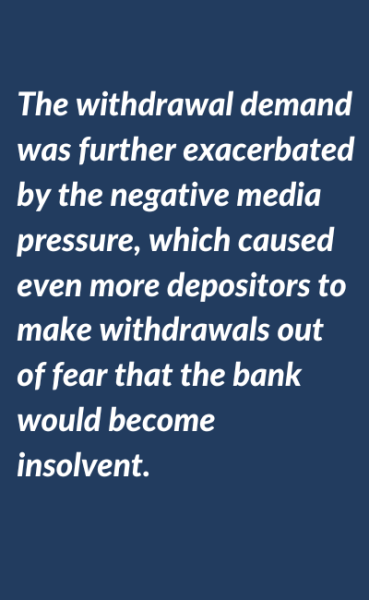News & Insights
The Ripple Effect of Failed Banks
March 17th, 2023
|
Wealth Management
Several banks have come under scrutiny as depositors have lost trust in the safety of their deposits and, so far, three banks have failed: Silvergate Bank, Silicon Valley Bank, and Signature Bank.
These failures have stirred panic in all things tied to money and finance, specifically causing a ripple effect through the banking sector.

Regional Bank Risks
A regional bank is traditionally a savings and loan institution taking in customer deposits and issuing loans to borrowers. Such banks tend to provide financial services to the areas and communities they belong to, as the name, regional, implies. As a result, these banks tend to be more concentrated in loans issued to borrowers located in specific geographical locations or market sectors, unlike the major diversified banks, such as JP Morgan Chase, Bank of America, and Wells Fargo.
Run on the Bank
Banks are in the business of earning money for the shareholders. They do this by accepting deposits and lending money to borrowers to earn an interest rate spread. Banks and shareholders can profit when the borrowing interest rate exceeds the cost of acquiring deposits. However, when banks make a series of bad loans that result in credit losses and the market catches wind, it can create a situation where depositors reacting in fear line up to get their deposits out, which exemplifies the classic term, “run on the bank.”
The banking system typically operates smoothly and is self-sustaining because it’s rare that any single depositor, let alone a large group of depositors, would demand all of their deposits back at any given point in time. Typically, depositors withdraw funds in smaller increments and banks can meet this demand due to the highly liquid and short-term reserves that banks must have available. However, when the public has lost confidence in a bank and there is a run, the bank may not have enough reserves to cover the resulting withdrawal demand.
Banking Failure History
The last time we saw something like this in our economy was during the Great Financial Crisis of 2008 when Lehman Brothers was allowed to fail, which set off a wildfire of credit defaults and other financial contagions. The aftermath of that event led to new legislation, regulations, and other reforms in the United States and the rest of the world, known as the Dodd-Frank Act and Basel Accords. These new rules and regulations helped usher in and transfer new regulatory oversight and raised the bar on old standards governing capital, market, and operational risks. To date, consensus opinion views these banking regulations to be widely successful and responsible for maintaining a more solvent and secure system.
Fortunately, the rate at which the market experiences bank closures has slowed considerably. For example, according to Federal Reserve Bank analysts that study banking history, bank failures were far more common between 1921 and 1929, averaging between 500 and 1000 per year. Between 1930 and 1933, the number of banks failing annually was in the thousands. Of course, the banking system of the past has little resemblance to the one of today. The number of banks belonging to the Federal Reserve System back then was a much smaller fraction than it is now. But in more recent times, from 2001 through 2022, 560 bank failures have occurred over a 22-year cycle, with many of those clustered in the aftermath of 2008. Ultimately, the institution of banking has become a more successful practice as the economy has developed and grown.

The collapse of SVB involves two key ingredients. First, the SVB’s assets experienced a market value decline relative to book value.
Second, the bank experienced significant withdrawal demand due to the risks associated with its borrowers and depositors.
Market Value of Assets
Silicon Valley Bank was once a $14 billion entity in equity value. As of December 31, 2022, it held $173 billion in deposits, a loan book of $74 billion, investments reported at $91 billion (if held to maturity), and marketable securities and cash worth nearly $40 billion. At face value, the assets of loans, investments, and cash and marketable securities more than covered the bank’s deposit liability. However, as it concerns stakeholders and regulators, the bank’s reported assets didn’t match the market value if the bank were to sell the assets. For example, the bank reported a -16% market value loss on its held-to-maturity assets.
One reason for the discrepancy is the way General Accepted Accounting Principles (GAAP) require institutions to carry held-to-maturity or fixed income investments at cost and to amortize the cost over the life of the investment. These recent market losses make it harder to service bank deposits. Therefore, depositors might rightly worry about the bank’s ability to repay its deposits. The bank’s asset impairments are likely a consequence of the rising economic interest rates and a slowdown in the deposit inflow activity from the bank’s primary segment of customers.
— One reason for the discrepancy is the way General Accepted Accounting Principles (GAAP) require institutions to carry held-to-maturity or fixed income investments at cost and to amortize the cost over the life of the investment.
In addition to the asset-value concerns, SVB’s stakeholders became increasingly concerned with the type of investments the bank purchased and recorded as available-for-sale investments. Instead of placing deposits in more guaranteed sources of investment risk, like US Treasury securities, the bank invested almost entirely in collateralized mortgagebacked securities subject to higher market losses and credit defaults. The market value of assets continued to decline due to continued interest rate hikes in 2023.
Significant Withdrawal Demand
 The bank decided to liquidate assets at depressed prices to cover its mounting withdrawal demand. This withdrawal pressure was primarily due to the bank’s concentration of clients in the technology start-up, private equity, and venture capital industries. These industries have been negatively impacted by rising interest rates, causing an increasing need for capital. Not only did these companies require access to their deposits; they also began experiencing difficulties in securing new credit lines and found it harder to pay off and refinance old credit lines.
The bank decided to liquidate assets at depressed prices to cover its mounting withdrawal demand. This withdrawal pressure was primarily due to the bank’s concentration of clients in the technology start-up, private equity, and venture capital industries. These industries have been negatively impacted by rising interest rates, causing an increasing need for capital. Not only did these companies require access to their deposits; they also began experiencing difficulties in securing new credit lines and found it harder to pay off and refinance old credit lines.
In addition, a slowdown in venture capital financing means deposits are likely to slow inside the bank. This further compounds the problem, given that the bank’s primary financing source, which helps manages liquidity and reserves to meet depositor demands, may even start to shrink. A combination of potentially impaired asset values and a shrinking deposit base can create reasons why a rational depositor would like to withdraw deposits.
The withdrawal demand was further exacerbated by the negative media pressure, which caused even more
depositors to make withdrawals out of fear that the bank would become insolvent. In the current technology-enabled world, this type of media attention can be devasting because there are no real frictions to prevent mass withdrawals.

Silvergate catered to institutional investors in hedge funds, venture capital, private equity, and family offices specializing in digital currencies.
Customers were attracted to this bank because of the access it offered to conduct digital currency exchanges, and the bank acted as a digital depository institution.
The bank would use digital currency deposits to make loans in other speculative activities, such as loans to help finance the growth of digital exchanges, and essentially act as a broker that would wrap mortgages into securities and sell them on the secondary market. Much of the concern over Silvergate’s viability began when the company failed to file its last annual report on a timely basis due to the risky nature and heightened volatility of the bank’s business practices.
Signature Bank began operating in New York but by 2018 had expanded into the West coast. This bank prides itself on serving a unique breed of private clients, primarily general partners that operate in private equity markets. The type of loans it made were generally to investment funds that were floating rate and callable. They also facilitated mortgage brokerage services and were adjacent to digital asset markets. Unfortunately, the bank stumbled on more difficult times as deposit growth from digital customers slowed and the risky nature of their loan book began to take its toll on the business.
— As the digital currency market has experienced significant price declines, businesses operating in those markets required significant withdrawals.
Similar to SVB and among other challenges, both Silvergate and Signature experienced rapid run-on-the-bank events as a result of their concentrated business models. As the digital currency market has experienced significant price declines, businesses operating in those markets required significant withdrawals. And, because bank asset values have generally been in decline due to rising rates, these banks were forced to liquidate those assets at a loss in order to meet the withdrawal needs of depositors.

The failed banks are officially closed and were put in receivership by the federal authorities. In addition, the federal authorities have guaranteed the depositors of these failures that they will get one hundred percent of their deposits back. Traditionally, depositors are only insured up to $250,000 by the Federal Deposit Insurance Corporation (FDIC).
But given the extremity of the situation and the financial wildfire that could spread, ranging from credit defaults to missed payrolls, regulators stepped in quickly to provide a backstop. In addition, regulators are looking for likely buyers who can come in and back deposits for the creditors of these failed banks. For instance, HSBC, a London-based bank, has already offered to buy Silicon Valley’s United Kingdom arm. There may be more announcements to come as some banks probably see an opportunity here to gain new client relationships and strengthen brands, backstop the banking industry from further distress, and earn a profit.
These failures have consequences for the entire banking sector in the economy. As a result, many bank shares in the stock market are experiencing sizable losses. The merit of a community bank often resembles the economic strength of the community where it operates. Therefore, these bank failures can potentially erode the public’s confidence and slow down deposit growth in smaller banks, impacting those local economies. Further, these situations can be evidence that other banks with other unique concentrated business models could experience a similar outcome based on the current economic and monetary policy environment. No one knows how widespread this problem is throughout the entire banking universe. How many other bank investments are negatively impacted by higher interest rates? What is the quality of the loans coming out of a zero-percent interest rate regime? In some ways, this current event is a throwback to the savings and loans crisis that started in the late 1970s and early 1980s. Many of the same problems existed back then, including higher interest rates in response to the inflation of that time.
— These failures have consequences for the entire banking sector in the economy. As a result, many bank shares in the stock market are experiencing sizable losses.
With all that said, these failed banks are clearly unique regarding the geography and clients they once served and, in our opinions, are not systemically important financial institutions that can ruin the entire financial system. Many banks nationwide are not involved with crypto currency, nor do they extend loans to private equity or venture capital firms. Most regional banks underwrite traditional mortgages and commercial loans to ordinary people living on Main Street. Finally, it is clear that the authorities in charge realize the importance of local banking and are aggressively taking steps to regain the public’s confidence.
Contact the Maner Wealth experts with questions at maner@manercpa.com.






